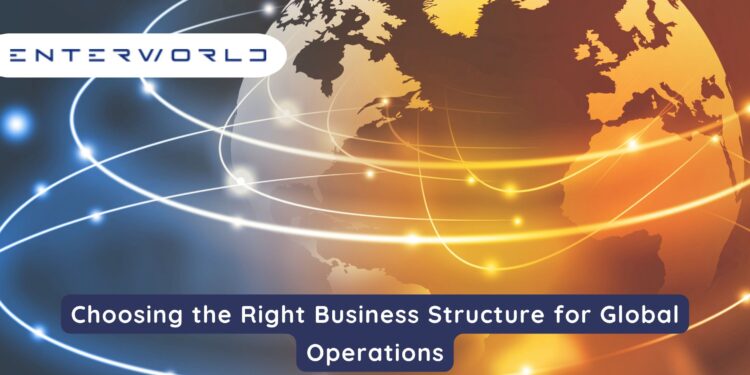Expanding a business across borders presents a world of opportunity—larger markets, access to diverse talent, and increased brand reach. However, success in international business starts with a crucial decision: selecting the right business structure. The structure you choose not only influences your tax exposure and regulatory obligations but also impacts operational flexibility, investor confidence, and long-term scalability.
This guide explores the main types of business structures available for global operations, how they function, and the factors to consider when choosing the right one for you to start a global business.
Why Business Structure Matters
When establishing a presence in a new country, businesses often rush into forming entities without a clear understanding of the legal and financial consequences. Choosing the wrong structure can lead to:
- Double taxation
- Legal liability
- Regulatory compliance burdens
- Operational inefficiencies
By selecting the most appropriate entity from the outset, you lay a solid foundation for sustainable growth, risk mitigation, and cost-effective operations.
Common Business Structures for International Expansion
1. Representative Office
A representative office is a simple way to establish a local presence without engaging in commercial activities. It’s ideal for conducting market research, liaising with partners, or promoting the parent company’s services.
Pros:
- Minimal setup costs
- Eases entry into unfamiliar markets
- No local taxation on profits (since it cannot earn income)
Cons:
- Cannot conduct revenue-generating activities
- Often subject to tight regulatory restrictions
- Limited operational capability
Best For: Market exploration or early-stage entry into a country.
2. Branch Office
A branch office is an extension of the parent company that can legally conduct business in the host country. However, it’s not a separate legal entity.
Pros:
- Can carry out business operations and generate income
- Simpler reporting lines to the head office
- Lower setup and operational costs than subsidiaries
Cons:
- The parent company bears full liability for branch activities
- May face higher taxation without local tax benefits
- Profits may be subject to withholding tax when remitted
Best For: Companies looking for direct operational control without forming a separate company.
3. Subsidiary (Local Corporation)
A subsidiary is a separate legal entity incorporated in the host country. It can be wholly or partially owned by the parent company.
Pros:
- Limited liability for the parent company
- Eligible for local tax incentives and treaties
- Greater credibility with customers, banks, and regulators
Cons:
- Higher administrative and legal costs
- Separate corporate governance and compliance requirements
- More complex tax and accounting obligations
Best For: Long-term commitments, high-value operations, and accessing local financing.
4. Limited Liability Company (LLC)
An LLC combines elements of a corporation and a partnership. In global contexts, many countries offer equivalent structures (e.g., GmbH in Germany, SARL in France).
Pros:
- Limited liability for owners
- Flexible internal structure
- Pass-through taxation in some jurisdictions
Cons:
- Varies significantly by country
- Restrictions on ownership and profit distribution in some cases
Best For: Medium-scale global operations needing both protection and flexibility.
5. Joint Venture (JV)
A joint venture involves partnering with a local entity to create a new business, often required in countries that restrict foreign ownership.
Pros:
- Access to local knowledge, customers, and networks
- Shared risk and investment
- Can navigate regulatory restrictions more easily
Cons:
- Risk of conflict with the local partner
- Complex agreement structures
- Limited exit strategies
Best For: Entering restricted or highly regulated markets like China or the Middle East.
Factors to Consider When Choosing a Business Structure
No one-size-fits-all solution exists when it comes to global business structures. Your decision should align with your business goals, operating model, and the regulatory landscape of the host country.
1. Legal Liability
How much legal protection does your chosen structure offer? A branch leaves your main company exposed, while a subsidiary provides a legal buffer.
2. Tax Implications
Examine how your structure affects corporate tax, VAT/GST, and withholding taxes. Treaties between your home and host countries may influence this choice.
3. Operational Control
If you need autonomy to make decisions locally, a subsidiary or LLC might be more suitable than a branch or JV.
4. Cost and Complexity
Setting up a subsidiary is more complex and costly than opening a branch. Factor in incorporation fees, accounting, reporting, and legal compliance.
5. Scalability
Choose a structure that supports growth. If your business is likely to expand rapidly, ensure the entity type can accommodate such scaling.
6. Regulatory Environment
Local laws might limit what foreign entities can do. Some countries mandate local directors, minimum capital requirements, or foreign ownership caps.
7. Exit Strategy
Consider how easy it will be to dissolve, sell, or repatriate profits from the entity when business objectives change.
Real-World Examples
- A U.S. software firm entering the U.K. might choose an LLC equivalent to benefit from limited liability while maintaining simplified tax filings.
- A manufacturing company entering India may prefer a wholly owned subsidiary to access tax incentives and comply with FDI norms.
- A consulting business exploring Japan could start with a representative office before fully committing to a branch or subsidiary.
The Role of Professional Advice
Given the complexity of international business structuring, it is advisable to work with legal and tax advisors in both your home country and the host country. They can help you navigate regulatory requirements, double tax treaties, and compliance standards specific to your industry.
Accountants can also assist in modeling different scenarios to compare the financial outcomes of each structure, helping you make a well-informed decision.
Conclusion
Choosing the right business structure for your global operations is a strategic decision that shapes your company’s future abroad. It affects everything from how you pay taxes and manage liability to how much flexibility and control you retain. Take the time to evaluate your goals, do jurisdiction-specific research, and seek expert guidance. A thoughtful choice now can lead to smoother operations, reduced risks, and maximized returns in the future.
FAQs
1. What is the best business structure for international expansion?
There’s no single best structure. It depends on your goals, industry, and the legal and tax environment in the host country. Subsidiaries offer the most protection, while branches are easier and cheaper to set up.
2. Do I need a local partner to start a business abroad?
In some countries, yes. Jurisdictions like the UAE or China may require foreign businesses to form a joint venture with a local entity depending on the sector.
3. How does a business structure impact taxation?
Different structures affect your tax liability, both locally and internationally. Subsidiaries may benefit from tax treaties and local incentives, while branches may be taxed as extensions of the parent company.


























